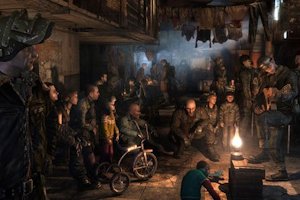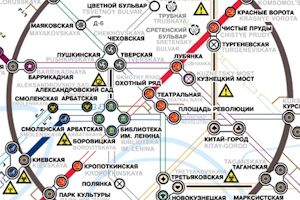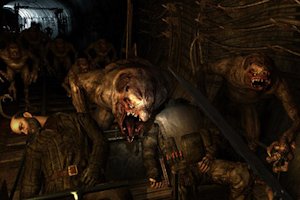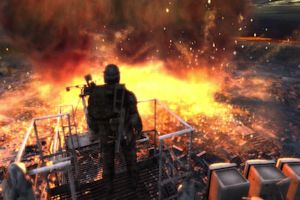Metro 2033: Differences between the Novel and the Game - Page 2
The Characters
 | | Prepare to keep notes |
Throughout the story--in both the novel and the game--Artyom encounters several characters who accompany him for various parts of his adventure. There's the seedy Bourbon, the enigmatic Khan, and the no-nonsense soldier ("Melnik" in the book, "Miller" in the game). These characters are more idiosyncratic in the novel--especially Khan--which makes them more memorable as individuals, whereas in the game, they all seem relatively the same as guides who can easily be switched with each other. In my memory of my two playthroughs of the game, there are several parts where I know I was with another character, but I'm at a loss as to which one it was, though I'm much more confident in placing the characters in their respective scenes in the novel.
The novel also has quite a few more of these characters, such as Mikhail and Vanechka, an elderly angina-suffering man and his mentally challenged son who lead Artyom to his first encounter with the fascists. Some characters who appear very briefly in the game also have expanded roles in the book, and some characters are merged from the novel, such as Ten and Daniel, the stalker/ranger and friendly knowledge-keeper who join Artyom and Melnik to the library. In the game, these two characters become Danila, and he is far more forgettable than the novel's Daniel, who Artyom shoots after he is mortally wounded by a librarian.
These differences between the novel and game again owe their existence to the novel's innate ability to go into better detail than the game can. Video games can certainly have memorable characters, but it is difficult--if not impossible--to stuff as many into a game as you can into a book. Having said that, I think both the Metro 2033 novel and the Metro 2033 game have too many ancillary characters. Despite axing at least half the total number of characters from the novel, the game still has too many to really keep track of, and their overall lack of idiosyncracy makes them even harder to remember than the numerous characters from the book. This, I guess, is a shortcoming of the story itself, and not a good exemplar of the differences between artforms.
The Stations
 | | Where's Turgenevskaya again? |
Similarly, both the video game and the novel have several locations based on real-world stations within the Moscow Metro. The video game has fewer of them and the names are less cumbersome. Instead of the difficult to say over and over again VDNKh, for example, the game calls Artyom's home Exhibition, and instead of Prospekt Mira, the market station is simply called Market Station. The novel lists practically every station in the Metro, and Artyom visits almost half of them in his travels. They tend to have cumbersome, difficult-to-remember names like Pushkinskaya, Smolenskaya, Mayakovskaya, Alekskeevskaya, and my personal favorite, Krasnopresnenskaya. Throughout the novel, there are moments where Artyom is trying to plot out his journey through the stations, and those sections are completely incomprehensible without looking at a Metro map, which the paperback I was reading failed to provide me. The game is far less confusing because it keeps things simple, but the map it shows you at the start of each chapter can get perplexing because it doesn't really explain why Artyom doesn't take direct routes to his destinations.
Though Artyom visits far fewer of these stations in the game, they are actually more memorable because they are so much more visually striking and different. Glukhovsky tries with enthusiasm to describe each station in loving detail and make them unique, but he largely fails after his fourth or fifth description of dark archways and collections of tents. All I remember from the book is that Kitay-Gorod is split in half and Polis is really, really bright, but all the other stations look pretty much the same in my mind. In the game, however, I can remember several different and interesting stations, and if I go online and check out the pictures of the real world locations upon which they are based, it's far more striking to compare them to the game recreations than the mind-numbing descriptions of the novel.
Still, the novel is more realistic in its depictions of the stations. Though it makes for good and memorable level design, Glukhovsky never once describes a station built on rails that are fifty feet above the ground. A video game can get away with stretching the laws of probable physics well beyond the breaking point, because a slavish devotion to realism would actually harm the experience. A novel, on the other hand, doesn't have quite as much leeway with its audience's suspension of disbelief, although it's hard to punish a novel about radioactive psychic mutants in a post-apocalyptic metro line for a lack of realism.
The Scenes
 | | The book has a distinct lack of high-speed knife battles with giant rat monsters |
Though the major plot beats are all the same, the novel and game deviate in several ways and have great scenes that aren't shared between them. The game's best scenes include Khan leading Artyom through a ghost tunnel, Artyom being smuggled to the front lines under a railcar, a chase involving a Panzer tank, and an intense surface battle on the way to the climax that serves as the game's preface. The novel, though missing all of that, has its own memorable scenes, including Artyom being hung by the fascists, his capture and escape from the Great Worm Cult, the time he has to hide from one the flying creatures in a tiny news kiosk filled with the scrawlings of a woman who died waiting for the apocalypse to end, and his spiritually meaningful encounter with the possibly hallucinatory wise men and their cat at the abandoned Polyanka station.
The scene that I think is most instructive in talking about the differences between the artforms, however, occurs in both the novel and the game, though they are both quite different in execution. It happens early in the story, when Artyom first leaves his home at VDKNh/Exhibition with a small group of comrades. In the novel, Artyom's companions go insane and start to pass out as they travel through the tunnel to Rizhskaya, and Artyom comes to realize that it has something to do with sound coming out of the pipes that he is somehow immune to. He rescues his companions and makes it to the end of the tunnel. In the game, however, Artyom and his companions are in a fast-moving cart that is forced into an unfamiliar tunnel, they all pass out (including Artyom), and when they awake, they are beseiged by nosalises and Artyom falls behind.
It's a far more intense and exciting scene in the game, and a more disturbing one in the novel. It also makes more logical sense in the game that weird things would happen on a less-traveled tunnel, but it works in the novel because it prepares readers for the unpredictable hazards that await in even the most familiar places. Neither scene is "better" in any conventional sense, but they each help set a tone for the story that is more in line with the medium being used to tell it.
The Endings
 | | Spoiler alert |
The conclusion to any story is arguably the most important thing to get right. It can either make or break a narrative, can lock in a thematic point that has been building up since the very beginning or prove that the storyteller was just making it all up all along. The final pages of the novel Metro 2033 do not disappoint, revealing a stunning twist that shines a new light on everything that has happened, explaining things that seemed inexplicable, and providing a gut-wrenching final blow as Artyom puts it all together just a few moments too late, watching in horror as he succeeds in a mission he realizes was woefully misguided from the start. It offers a bold and uncomfortable commentary on society and humanity, along with very little hope that the characters in Gluskovsky's universe will ever make it out of the Metro. It is the perfect resolution to the story, and I can't imagine it being done any better.
One of the great things about video games, though, is that they can offer multiple endings, depending on how the game is played. Though this gimmick rarely succeeds, Metro 2033 provides two possible outcomes. To set the stage, both the book and the game end with Artyom climbing to the top of Ostankino Tower to help guide a volley of missiles into the heart of the dark ones' territory in Moscow's Botanical Gardens, hoping to wipe them out for good and save the Metro. The regular "Ranger" ending to the game involves Artyom shooting a dark one that is trying to stop him and allowing the missiles to reach their destination, and he ponders as he watches the explosions whether or not he has done a good thing. The more complete "Enlightened" ending involves Artyom sparing the dark one and shooting the guidance system off the tower instead, not letting the missiles go as he realizes at the last second that the dark ones have been trying to communicate with him all along. These endings are provocative and interesting, but they lack any real closure or explanation.
The ending of the novel explains what the dark ones actually are--a lifeform evolved to not only survive but thrive on the surface of an irradiated Earth and who are trying to reach out to humanity for help only to have humanity grossly misunderstand and attempt to kill them--and it explains that the dark ones have been influencing Artyom from the very start, because he is the first human they have found any compatability with. Artyom realizes that the dark ones are humanity's last chance at redemption, but this comes mere moments before they are eradicated by the missiles he helped launch. Without question, I prefer the novel's ending to either of the games'. The endings to the game are still acceptable and appropriate, and it would be hard for either of them to fully explain the bitter irony that defines the novel's conclusion.
It boils down the differences in the medium and helps reveal the fact that video games still have some growing up to do before they can achieve the kind of social commentary a good novel can. This is not to say I agree with Ebert's assertion that video games are wholly incapable of such meaningful expression--far from it--but that a better understanding of what makes video games a unique form of expression will lead to more mature storytelling in the future.
-e. magill 9/10/2013
|
|